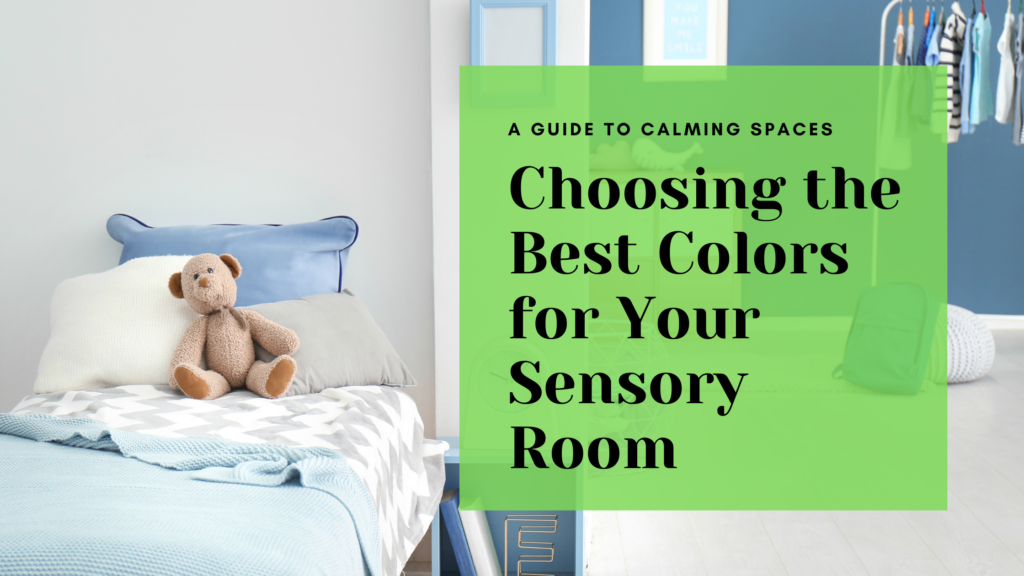I. Introduction
The Importance of Sensory Rooms for Autism
Sensory rooms are special spaces designed to help individuals with autism manage sensory processing challenges. These rooms provide a controlled environment where people can engage with different sensory stimuli in a way that feels safe and comfortable. For many individuals with autism, sensory rooms are essential because they help reduce anxiety, improve focus, and promote relaxation.
Creating a sensory room at home is becoming increasingly popular. Many parents and caregivers are choosing to build these spaces themselves, not only to save money but also to customize the room to fit the specific needs of their loved ones. A DIY sensory room can be tailored exactly to the preferences and challenges of the individual, making it a powerful tool for enhancing well-being.
Purpose of the Guide
This guide will walk you through the process of creating a DIY sensory room. Whether you’re starting from scratch or looking to improve an existing space, this article will provide you with step-by-step instructions on how to build a sensory-friendly environment at home. The great thing about a DIY approach is that it’s affordable, and you have full control over the design and materials used. By the end of this guide, you’ll have all the information you need to create a sensory room that meets the unique needs of someone with autism.
II. Planning Your DIY Sensory Room
Assessing Sensory Needs
Before you start building your sensory room, it’s important to understand the specific sensory needs of the person who will use the space. People with autism often have different sensory preferences. Some might be sensitive to bright lights, loud sounds, or certain textures, while others might seek out these stimuli.
To assess these needs, observe the person’s reactions to different environments and activities. You might also want to consult with professionals, such as occupational therapists, who can provide insights into the individual’s sensory challenges and preferences. Understanding these needs will help you choose the right elements for the room, making it a more effective and comforting space.
Choosing the Right Space
The next step is choosing the best location in your home for the sensory room. Consider factors like room size, natural light, noise levels, and how close the room is to other activities in the house. Ideally, the sensory room should be in a quiet area where the person can relax without being disturbed by household noise.
If space is limited, you can still create an effective sensory area in a smaller room or even a section of a larger room. The key is to make sure the space is comfortable and free from distractions, allowing the person to fully engage with the sensory tools and activities.
Setting a Budget
Setting a budget is an important part of planning your DIY sensory room. The cost of creating a sensory room can vary widely depending on the materials and equipment you choose. Start by estimating the total cost and then prioritize the most important items that will have the biggest impact on the user’s experience.
There are many cost-effective solutions available, from DIY projects to finding deals on sensory equipment. For example, you can make your own sensory bins or fidget toys using inexpensive materials, or repurpose items you already have at home. By being creative and resourceful, you can build a sensory room that meets your needs without overspending.
III. Essential Elements of a DIY Sensory Room
Calming Colors and Lighting
- Choosing the Right Colors: The colors you choose for the sensory room can greatly affect the mood of the space. Soft, calming colors like blues, greens, and neutrals are ideal for creating a soothing environment. These colors can help reduce anxiety and make the room feel more peaceful. Avoid bright, bold colors that might be too stimulating, especially for someone with sensory sensitivities.
- Lighting Options: Lighting is another crucial element in a sensory room. Adjustable lighting, such as dimmable LED lights, allows you to control the brightness according to the person’s needs. Natural light is also beneficial, but it’s important to have options like blackout curtains to block out light when necessary. The ability to change the lighting helps create different moods, making the room more versatile and effective.
Tactile and Sensory Play Areas
- Tactile Walls and Surfaces: Tactile stimulation is an important aspect of many sensory rooms. You can create tactile walls using DIY materials like fabric, foam, and textured wallpaper. These surfaces provide different textures for the person to touch and explore, which can be both calming and engaging. For example, you might include a section of the wall covered in soft fabric, another with rough textures, and another with smooth, cool surfaces.
- Sensory Bins and Fidget Toys: Sensory bins are containers filled with various materials, such as sand, rice, or beads, that the person can dig their hands into. These bins offer a hands-on experience that is soothing and helps improve focus. You can also make or source fidget toys, which are small items that can be squeezed, twisted, or stretched. These toys are great for providing sensory input and helping to calm anxiety.
Comfortable Seating and Safe Spaces
- Soft Seating Options: Comfortable seating is essential in a sensory room. You can create seating areas using bean bags, cushions, or padded nooks where the person can relax and feel secure. These soft seating options provide a cozy spot for taking breaks and enjoying quiet time, which is important for reducing sensory overload.
- Creating a Safe, Quiet Space: In addition to seating, it’s important to design a quiet corner or retreat within the sensory room. This area should be free from distractions and offer a safe place for the person to unwind. You might include soft lighting, soothing sounds, and favorite items like blankets or stuffed animals to make the space feel comforting and secure.
Auditory and Visual Stimulation
- Sound Machines and Music: Auditory stimulation can be a powerful tool in a sensory room. Consider incorporating sound machines that play calming sounds, such as ocean waves or rain. Gentle music can also be soothing, especially if it’s something the person enjoys. These sounds help create a peaceful atmosphere and can be used to mask background noise that might be distracting.
- Visual Stimulation Tools: Visual tools like light projectors, bubble tubes, or simple LED strips can add another layer of sensory input. For example, a light projector can cast soft images onto the walls or ceiling, creating a calming visual experience. Bubble tubes provide both visual and auditory stimulation with their gentle movement and changing colors. These tools help create a visually engaging environment that promotes relaxation.
Movement and Balance Equipment
- DIY Sensory Swings: Movement is another important aspect of sensory rooms, especially for those who benefit from vestibular stimulation. You can install a sensory swing or hammock in the room to provide gentle rocking or swinging motion. This type of movement helps with balance and can be very calming for individuals with autism.
- Balance and Rocking Tools: In addition to swings, consider adding balance boards or rocking chairs to the room. These tools offer a way for the person to engage in movement while also improving balance and coordination. Rocking chairs, in particular, provide a rhythmic motion that can be soothing and help reduce anxiety.
IV. Step-by-Step Guide to Building Your DIY Sensory Room
Step 1: Planning and Designing Your Space
Start by creating a floor plan and designing the layout of your sensory room. Think about how the different elements will work together and where each item should be placed. Consider the sensory needs you’ve assessed and plan the room accordingly. For example, you might want to place calming items like soft seating and tactile walls in one area, while keeping more stimulating items like balance boards or swings in another.
Step 2: Gathering Materials and Tools
Next, gather the materials and tools you’ll need for your DIY sensory room. This might include paint, fabric, foam, lighting, and various sensory tools. Look for affordable supplies at craft stores, online marketplaces, or even around your home. Be sure to choose materials that are safe and appropriate for the person’s age and needs.
Step 3: Assembling and Installing Equipment
Once you have all your materials, it’s time to assemble and install the sensory room equipment. Follow any instructions carefully, especially when it comes to safety. For example, if you’re installing a swing, make sure it’s securely anchored to the ceiling and can support the person’s weight. Safety is key, so take your time to ensure everything is properly set up.
Step 4: Personalizing and Final Touches
Finally, add personal touches to the sensory room. This might include decorating with the person’s favorite colors, themes, or items that make them feel comfortable. Adding these final touches makes the room feel like a special place tailored just for them. Personalization is important because it helps the person feel more connected to the space and more likely to use it effectively.
V. Tips for Maintaining and Evolving Your Sensory Room
Regular Maintenance and Cleaning
To keep your sensory room effective and welcoming, it’s important to maintain and clean it regularly. Make sure the room stays organized and that the equipment is in good working condition. Cleaning the space helps create a fresh, calming environment that feels good to be in.
Adapting as Needs Change
Over time, the sensory needs of the person using the room may change. It’s important to regularly assess how the room is being used and make any necessary adjustments. You might need to add new items, remove things that are no longer helpful, or rearrange the space to better meet the person’s evolving needs.
Incorporating Feedback from the User
One of the best ways to ensure the sensory room remains effective is by regularly checking in with the person using it. Ask them how they feel about the space and if there’s anything they would like to change. Their feedback is invaluable in making sure the room continues to meet their needs and provides a supportive environment.
VI. Conclusion
Recap of the DIY Sensory Room Process
Building a DIY sensory room is a rewarding project that can have a big impact on the well-being of someone with autism. By understanding their sensory needs, choosing the right space, and carefully planning the room, you can create a space that is both calming and engaging. From tactile walls to sensory swings, each element of the room plays a role in helping the person feel more comfortable and in control.
Encouragement to Start Building
If you’re considering creating a sensory room, don’t hesitate to start planning and building. Even small steps can make a big difference in creating a space that supports sensory needs and promotes relaxation. The benefits of having a sensory room at home are significant, offering a place where the person can feel safe, calm, and happy.
We encourage you to share your own DIY sensory room projects, seek out additional resources, and consult with professionals if needed. Building a sensory room is a personal journey, and there are many ways to make it work for your unique situation. Explore different ideas, connect with others, and enjoy the process of creating a space that truly makes a difference.


